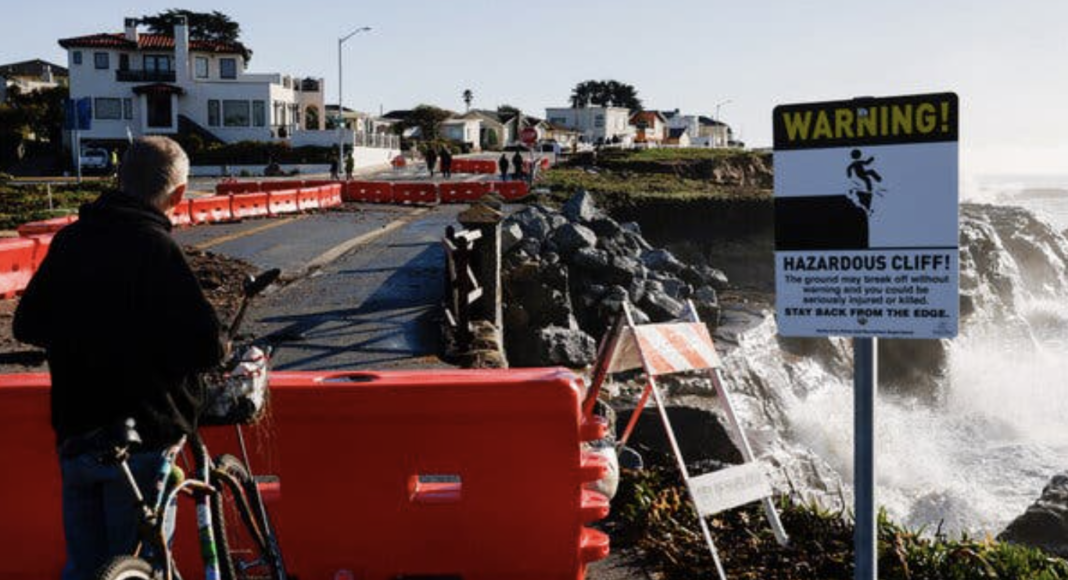By Soumya Karlamangla, The New York Times
SANTA CRUZ — West Cliff Drive is not a typical neighborhood thoroughfare.
High above the glittering blue waters of Monterey Bay, where surfers and seals bob in the waves, the small two-lane road hugs the surprisingly close edge of the cliffs. On a recent morning, a couple rode a two-seater bicycle along the roadway, soaking in the expansive views of the Pacific Ocean. A group wearing puffer jackets teetered on an impressive outcropping 40 feet above the water to snap a photo.
This 2.7-mile promenade attracts thousands of joggers, sightseers, cyclists and surfers each day. For many who live in Santa Cruz, the corridor feels like an essential part of the
identity of the funky beach city, about 75 miles south of San Francisco and home to 62,000 people.
“It’s so much more than a road,” said Hilary Bryant, a former mayor of Santa Cruz. “Tourists come here and they go to West Cliff Drive — it’s like our front yard.”
But the recent high-profile winter storms in California hit the region particularly hard, splitting the Capitola Wharf in half and prompting mudslides that shut down two freeways. Along West Cliff Drive, 20-foot-tall waves dragged chunks of the roadway into the sea, closing parts of the road for at least another six months.
The extensive destruction has forced the city to think about how to adapt to an increasingly eroding coastline as sea levels rise and storms become more violent — something many Santa Cruz residents had seen as hypothetical or as an issue to be dealt with in the distant future.
“This was sort of a wake-up call,” said Gary Griggs, a professor of earth sciences who has taught at the University of California, Santa Cruz, since the 1960s. “I’ve never seen this much damage this quickly in my 55 years here. So it’s time to step back and say, ‘This is what’s coming.’”
A majority of the state’s coast is lined by cliffs — and most of them are eroding. According to a study published in September, an average of two inches of California’s coast dribbles into the sea every year, though in some spots, like Eureka, it can be 10 times that amount.
This trend will only increase as oceans rise and storms become more powerful this century. That means many eyes are on Santa Cruz, as it decides how to tackle the problem of West Cliff Drive.
There aren’t any easy solutions. Among the possibilities: further bolster the cliffside with seawalls or boulders to preserve the two-lane road; narrow it to one lane to make room for the retreating coastline; or close it to cars altogether.
No decisions, or even proposals, have been made yet, but the future of West Cliff has dominated chitchat around Santa Cruz lately, said Fran Grayson, who owns Steamer Lane Supply, a cafe on West Cliff Drive overlooking the water.
“People are talking about it and stressing about it,” Grayson told me. That’s especially true among the surfers who treasure the breaks off West Cliff that helped make Santa Cruz a worldwide surfing destination.
The damage from the recent storms to West Cliff Drive will cost $13 million to repair, the city manager, Matt Huffaker, said, and without additional steps, the Santa Cruz coastline could sustain as much as $1 billion in erosion and other climate-related damage by the end of the century. “We can’t simply build back in the same way,” he said.
As I walked along West Cliff Drive recently, savoring the salty air, pedestrians peered over plastic barriers to get a better look at a spot where the asphalt had crumbled into the sea.
Gretchen Bach, who lives on a stretch of West Cliff that was among the hardest hit by the storms, said the impacts had not been all bad. True, closing one lane of the road has meant fewer parking options for her and her neighbors, but also less car traffic and more breathing room for people on foot.
“People stop and talk to each other, there’s just more space — it’s like our community meeting place,” Bach, who works as a real estate agent, told me. “I’d trade that for parking any day.”
Debates similar to the one around West Cliff Drive are likely to play out across California in the coming decades as the effects of climate change take their toll. According to the National Oceanic and Atmospheric Administration, some 200,000 Californians and almost $17 billion in residential and commercial buildings are at risk from coastal flooding alone. Without intervention, many highways, airports and recreational beaches will be damaged or destroyed.
In Santa Cruz, the reality of coastal erosion and climate change seemed to have sunk in among residents who treasure West Cliff Drive.
“If we do nothing, at some point, there will be nothing to protect and save,” Bryant said.
Soumya Karlamangla is a reporter with California Today, The New York Times. Copyright, 2023, The New York TImes















Meanwhile, all the people who bought expensive houses along West Cliff are now soiling their trousers as they worry about more erosion taking away access to their homes.
The logo for the city of Santa Cruz is the lighthouse at Steamers, but they have known for more than 20 years that the lighthouse is on fragile ground, being undermined by the waves below… and is in imminent danger of dropping into the drink, gone forever.
What has the city done to remedy this problem? Will they just stick bandaids on these newer erosion problems? We need city leaders who are PROActive, not REactive.